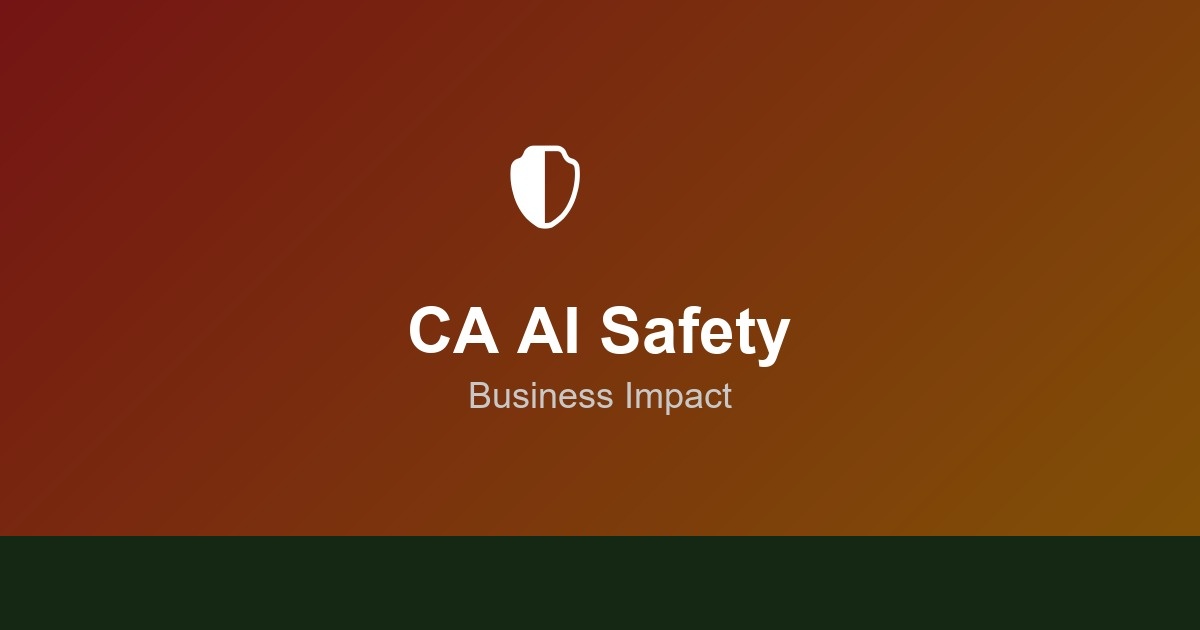Navigating the New Frontier of AI Regulation: What California's Sweeping Safety Bill Means for Your Bottom Line

California has once again taken a pioneering step in tech regulation, with Governor Newsom signing a comprehensive AI safety bill into law. For enterprise leaders and decision-makers, this isn't just another headline—it's a critical development that will reshape the landscape of AI adoption and governance. The key question on every executive's mind should be: **How does this new regulatory environment translate to ROI?**
California has once again taken a pioneering step in tech regulation, with Governor Newsom signing a comprehensive AI safety bill into law. For enterprise leaders and decision-makers, this isn't just another headline—it's a critical development that will reshape the landscape of AI adoption and governance. The key question on every executive's mind should be: How does this new regulatory environment translate to ROI?
Beyond Compliance: The Business Case for Proactive AI Governance
The new legislation, which includes provisions for transparency, accountability, and risk assessments, is not merely a compliance hurdle. Instead, it presents a strategic opportunity for businesses to build trust and create a competitive advantage. Companies that proactively embrace robust AI governance frameworks will not only mitigate legal and financial risks but also enhance their brand reputation and customer loyalty. As research from IBM suggests, investing in AI ethics has the potential to create quantifiable benefits and unlock new value.

The ROI of Responsible AI: A Framework for Success
For enterprises, the path to realizing the ROI of responsible AI lies in a structured approach that encompasses the following key pillars:
- Risk Mitigation: The most immediate return comes from avoiding costly penalties and legal battles. The EU's AI Act, for instance, proposes fines of up to 4% of global revenue for non-compliance. California's new bill, while different in its specifics, signals a similar trend toward significant financial repercussions for irresponsible AI development and deployment.
- Enhanced Decision-Making: By ensuring the accuracy, fairness, and transparency of AI models, businesses can improve the quality of their automated decisions. This leads to better resource allocation, optimized operations, and ultimately, a stronger bottom line.
- Increased Customer Trust: In an era of data privacy concerns and algorithmic bias, demonstrating a commitment to ethical AI is a powerful differentiator. Trust is a valuable currency, and companies that earn it will see a direct impact on customer acquisition and retention.
- Innovation and Growth: A clear regulatory framework can actually foster innovation by providing a stable and predictable environment for development. By understanding the rules of the road, businesses can confidently invest in new AI applications that drive growth and create new market opportunities.
The Cost of Inaction: A Cautionary Tale
Conversely, the failure to adapt to this new reality can have severe consequences. Companies that lag in their AI governance will not only face legal and financial penalties but also risk significant reputational damage. In today's hyper-connected world, a single incident of algorithmic bias or a data privacy breach can erode years of brand equity overnight. The story of a business that failed to properly vet its AI vendor, leading to a discriminatory automated hiring process, serves as a stark reminder of the potential pitfalls.

Your Next Move: Turning Regulation into a Competitive Advantage
The passage of California's AI safety bill is a clear signal that the era of unregulated AI is coming to an end. For enterprise leaders, the time to act is now. By viewing this as an opportunity rather than a burden, you can position your organization for long-term success in the age of AI. The first step is to conduct a comprehensive assessment of your current AI governance practices and develop a roadmap for aligning them with the new regulatory landscape. The future belongs to those who can navigate this new frontier with both innovation and integrity. Don't let compliance be a reactive burden; transform it into a proactive strategy for sustainable growth and market leadership. Engage with your legal and technical teams today to chart a course for responsible AI adoption that delivers tangible business value.
References
- Industry research and analysis from leading AI technology providers and research institutions.
- Enterprise AI implementation case studies and ROI analysis from Fortune 500 companies.
- Market research reports from Gartner, McKinsey, and other leading consulting firms on AI adoption trends.
- Technical documentation and whitepapers from AI platform vendors and service providers.
- Regulatory compliance frameworks and guidelines for AI implementation in enterprise environments.
Ready to Implement AI in Your Enterprise?
Our team of AI experts can help you navigate the complex landscape of AI infrastructure and implementation. Book a free consultation to discuss your specific needs.
Book Free Consultation